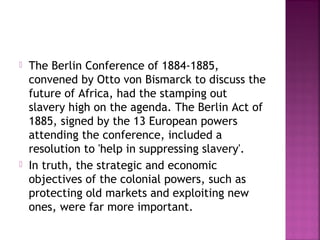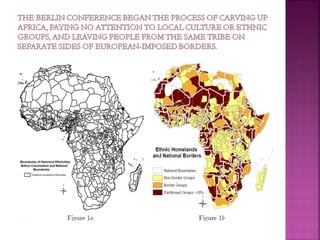African civilization scramble for africa
- 1. “Whatever happens we have got the maxim gun and they have not” —English poet Hilaire Belloc
- 2. Europeans partitioned Africa into spheres of influence, protectorates, colonies, and free- trade-areas. The borders designed in European capitals at a time when Europeans had barely settled in Africa and had little knowledge of the geography and ethnic composition of the areas whose borders were designing.
- 3. Until the 19th century, Britain and the other European powers confined their imperial ambitions in Africa to the odd coastal outpost from which they could exert their economic and military influence. British activity on the West African coast was centred around the lucrative slave trade. Between 1562 and 1807, when the slave trade was abolished, British ships carried up to three million people into slavery in the Americas. In total, European ships took more than 11 million people into slavery from the West African coast, and European traders grew rich on the profits while the population of Africa's west coast was devastated.
- 4. As late as the 1870s, only 10% of the continent was under direct European control, with Algeria held by France, the Cape Colony and Natal (both in modern South Africa) by Britain, and Angola by Portugal. And yet by 1900, European nations had added almost 10 million square miles of Africa - one-fifth of the land mass of the globe - to their overseas colonial possessions. Europeans ruled more than 90% of the African continent
- 5. One of the chief justifications for this so-called 'scramble for Africa' was a desire to stamp out slavery once and for all. Shortly before his death in May 1873 at Ilala in central Africa, the celebrated missionary- explorer David Livingstone had called for a worldwide crusade to defeat the slave trade controlled by Arabs in East Africa, that was laying waste the heart of the continent. The only way to liberate Africa, believed Livingstone, was to introduce the 'three Cs': commerce, Christianity and civilisation
- 6. This was a period in history when few Europeans doubted their innate superiority over the 'lesser' races of the world. The theory that all the peoples of Europe belonged to one white race which originated in the Caucasus (hence the term 'Caucasian') was first postulated at the turn of the 19th century by a German professor of ethnology called Johann Blumenbach.
- 7. Blumenbach's colour-coded classification of races - white, brown, yellow, black and red - was later refined by a French ethnologist, Joseph-Arthur Gobineau, to include a complete racial hierarchy with white-skinned people of European origin at the top. Such pseudo-scientific theories were widely accepted at the time and motivated Britons like Livingstone to feel they had a duty to 'civilise' Africa.
- 8. The Berlin Conference of 1884-1885, convened by Otto von Bismarck to discuss the future of Africa, had the stamping out slavery high on the agenda. The Berlin Act of 1885, signed by the 13 European powers attending the conference, included a resolution to 'help in suppressing slavery'. In truth, the strategic and economic objectives of the colonial powers, such as protecting old markets and exploiting new ones, were far more important.
- 10. End of the Slave Trade: Britain had had some success in halting the slave trade around the shores of Africa, but inland the story was different. Muslim traders from north of the Sahara and on the East Coast still traded inland, and many local chiefs were reluctant to give up the use of slaves. Reports of slaving trips and markets were brought back to Europe by various explorers, such as Livingstone, and abolitionists in Britain and Europe were calling for more to be done.
- 11. Exploration: During the 19th century, barely a year went by without a European expedition into Africa. The boom in exploration was triggered to a great extent by the creation of the African Association by wealthy Englishmen in 1788, who wanted someone to 'find' the fabled city of Timbuktu and the course of the Niger River. As the century moved on, the goal of the European explorer changed, and rather than traveling out of pure curiosity they started to record details of markets, goods, and resources for the wealthy philanthropists who financed their trips.
- 12. Capitalism: The end of European trading in slaves left a need for commerce between Europe and Africa. Capitalists may have seen the light over slavery, but they still wanted to exploit the continent. New 'legitimate' trade would be encouraged. Explorers located vast reserves of raw materials, they plotted the course of trade routes, navigated rivers, and identified population centers which could be a market for manufactured goods from Europe.
- 13. Military Innovation: At the beginning of the 19th century, Europe was only marginally ahead of Africa in terms of available weapons as traders had long supplied them to local chiefs and many had stockpiles of guns and gunpowder. But two innovations gave Europe a massive advantage.Europeans, with an eye to colonization and conquest, restricted the sale of the new weaponry to Africa maintaining military superiority.
- 14. Politics: After the creation of a unified Germany (1871) and Italy (a longer process, but its capital relocated to Rome also in 1871) there was no room left in Europe for expansion. Britain, France and Germany were in an intricate political dance, trying to maintain their dominance, and an empire would secure it. Germany, under the management of Chancellor Bismarck, had come late to the idea of overseas colonies, but was now fully convinced of their worth. It would need some mechanism to be put in place to stop overt conflict over the coming land grab.
- 15. Steam Engines and Iron Hulled Boats: In 1840 the Nemesis arrived at Macao, south China. It changed the face of international relations between Europe and the rest of the world. The Nemesis had a shallow draft (five feet), a hull of iron, and two powerful steam engines. It could navigate the non-tidal sections of rivers, allowing access inland, and it was heavily armed. Livingstone used a steamer to travel up the Zambezi in 1858, and had the parts transported overland to Lake Nyassa. Steamers also allowed Henry Morton Stanley and Pierre Savorgnan de Brazza to explore the Congo
- 16. Quinine and Medical Advances: Africa, especially the western regions, was known as the 'White Man's Grave' because of the danger of two diseases: malaria and yellow fever. In 1817 two French scientists, Pierre-Joseph Pelletier and Joseph Bienaimé Caventou, extracted quinine from the bark of the South American cinchona tree. It proved to be the solution to malaria; Europeans could now survive the ravages of the disease in Africa. Unfortunately yellow fever continued to be a problem, and even today there is no specific treatment for the disease.
- 17. Britain was primarily concerned with maintaining its lines of communication with India, hence its interest in Egypt and South Africa. But once these two areas were secure, imperialist adventurers like Cecil Rhodes encouraged the acquisition of further territory with the intention of establishing a Cape-to-Cairo railway. Britain was also interested in the commercial potential of mineral-rich territories like the Transvaal, where gold was discovered in the mid- 1880s, and in preventing other European powers, particularly Germany and France, from muscling into areas they considered within their 'sphere of influence
- 18. As a result, during the last 20 years of the 19th century, Britain occupied or annexed Egypt the Sudan British East Africa (Kenya and Uganda) British Somaliland Southern and Northern Rhodesia (Zimbabwe and Zambia) Bechuanaland (Botswana) Orange Free State and the Transvaal (South Africa) Gambia Sierra Leone Nigeria British Gold Coast (Ghana) and Nyasaland (Malawi). These countries accounted for more than 30% of Africa's population
- 19. The other chief colonisers were France, Germany, Belgium, Italy, Portugal and Spain.
- 20. The improper border partitioning led to ethnic struggles, patronage politics, and spurred civil conflict, leading to poverty and underdevelopment. By the end of 1966, 40 countries had gained independence. Many proposed changing the colonial borders, African leaders and leaving Europeans avoided this issue. The leaders of African independence believed that nation building would sideline ethnic divisions; moreover building new states and national institutions seemed more important than massive border realignment.
- 21. Likewise Europeans’ main objective was to maintain their special rights and corporate deals with their former colonies, and as such, they were reluctant to open the border issue. Thus almost all African countries accepted the colonial borders when signing the Charter of the Organization of African Union in 1964.
- 22. The three C’s The sense of cultural superiority Political competition and prestige Africa “The Dark Continent” Discuss the political, economic, social and cultural impact of scramble and subsequent colonization of Africa. Review Walter Rodney’s How Europe underdeveloped Africa and Jared Diamond’s Guns, Germs and Steel in reflection of the scramble and colonization of Africa.
Editor's Notes
- Some historians focus on ideological motivations in the late 19th century, that Europeans and Americans increasingly believed that they were destined to extend their culture abroad. These historians look for evidence of an upswing in European and American chatter about how their race and civilization was superior. For example, Josiah Strong, an American Congregationalist minister, explained in 1885 why he believed that the Anglo-Saxon race was destined to rule the world:
- It was a time of plantations and cash crops, dedicating the region's workforce to producing rubber, coffee, sugar, palm oil, timber, etc for Europe. And all the more enticing if a colony could be set up which gave the European nation a monopoly
- .
- Jared Diamond “Guns, Germs and Steel”





















